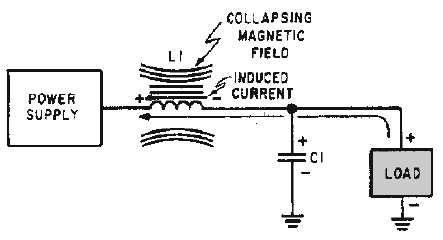4-17
Figure 4-14.—Inductive filter (collapsing field).
Now that you have read how the components in a filter circuit react to current flow from the rectifier,
the different types of filter circuits in use today will be discussed.
Q13. If you increase the value of the capacitor, will the XC increase or decrease? Why?
The Capacitor Filter
The simple capacitor filter is the most basic type of power supply filter. The application of the
simple capacitor filter is very limited. It is sometimes used on extremely high-voltage, low-current power
supplies for cathode-ray and similar electron tubes, which require very little load current from the supply.
The capacitor filter is also used where the power-supply ripple frequency is not critical; this frequency
can be relatively high. The capacitor (C1) shown in figure 4-15 is a simple filter connected across the
output of the rectifier in parallel with the load.
Figure 4-15.—Full-wave rectifier with a capacitor filter.
When this filter is used, the RC charge time of the filter capacitor (C1) must be short and the RC
discharge time must be long to eliminate ripple action. In other words, the capacitor must charge up fast,
preferably with no discharge at all. Better filtering also results when the input frequency is high;
therefore, the full-wave rectifier output is easier to filter than that of the half-wave rectifier because of its
higher frequency.
For you to have a better understanding of the effect that filtering has on Eavg, a comparison of a
rectifier circuit with a filter and one without a filter is illustrated in views A and B of figure 4-16. The



